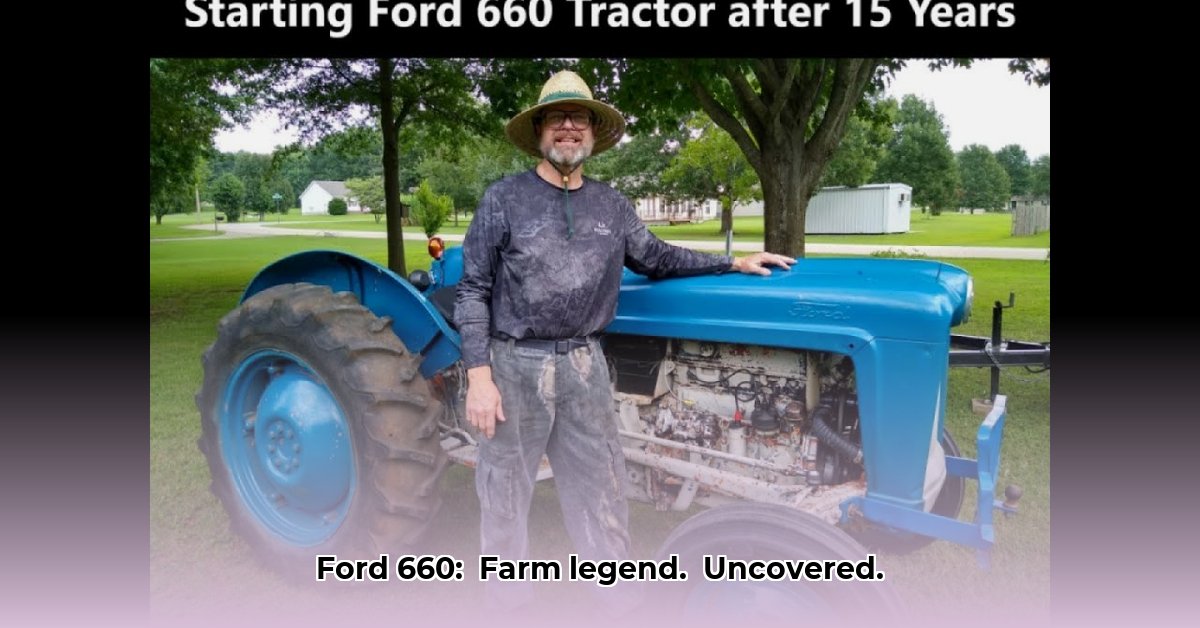
The Ford 660 tractor, produced between 1954 and 1957, represents a significant milestone in agricultural machinery. This article provides a comprehensive overview of its specifications, capabilities, history, and its enduring legacy among collectors and enthusiasts. We'll explore its performance, restoration challenges, and its lasting impact on farming. For more Ford tractor information, see this helpful Ford Tractor Guide.
Specifications and Capabilities: Power and Performance
The Ford 660, while modest by today's standards, offered impressive capabilities for its era. Its 134 cubic inch four-cylinder engine, though not the most powerful, provided reliable power for a range of agricultural tasks. While precise horsepower figures vary based on testing methodology (resulting in some inconsistencies in reported belt and drawbar horsepower), estimates typically range around 30 belt horsepower and 28 drawbar horsepower. This meant it could effectively handle plowing, planting, and harvesting.
Its five-speed, unsynchronized transmission (requiring double-clutching for smooth shifting, common for the time) offered a suitable range of gears for different field conditions. The live power take-off (PTO) ensured efficient operation of implements like hay balers and combines, while its three-point hitch system simplified attachment. Its open-center hydraulic system, although basic, adequately addressed the needs of the time.
Here's a summary of its key specifications:
| Specification | Value | Notes |
|---|---|---|
| Engine Type | 4-cylinder | Reliable and relatively easy to maintain. |
| Engine Displacement | 134 cubic inches | A solid size for its era. |
| Horsepower (Belt) | ~30 hp (Varied by Testing) | Test methodology varied, leading to inconsistent results. |
| Horsepower (Drawbar) | ~28 hp (Varied by Testing) | Test methodology varied, leading to inconsistent results. |
| Transmission | 5-speed Unsynchronized | Required double-clutching for smooth shifts. |
| PTO | Live | More efficient power transfer to implements. |
| Hydraulic System | Open Center | Simple, yet effective for implements of the time. |
| Weight | Approximately 3095 lbs | Manageable weight for various farming applications. |
| Wheelbase | 75.2 inches | Provided good stability during fieldwork. |
Wasn't the Ford 660's relatively low horsepower a limitation? While modern tractors vastly surpass its power, the 660 adequately addressed the needs of farmers in the mid-1950s. Its capabilities were sufficient for the majority of tasks performed on farms of that era.
Production and History: A Legacy of Innovation
The Ford 660 was part of the successful Ford 600 series, with production spanning from 1954 to 1957. Though initially starting with a relatively small production run in 1954, it quickly gained popularity, culminating in over 116,000 units produced by 1957. This success is a testament to the Ford 660's practicality and efficiency. Minor variations existed between model years and production runs, reflecting the ongoing evolution of design and manufacturing during that period. The introduction of the live PTO and five-speed transmission set the 660 apart from its predecessors, significantly enhancing its usability. Its design and features would influence future Ford tractor models.
Restoration and Collectibility: A Classic's Enduring Appeal
Today, the Ford 660 enjoys a dedicated following among collectors and enthusiasts. Many find satisfaction in restoring these machines, bringing them back to their former glory. While sourcing parts can be a challenge due to the tractor's age, online communities and specialized suppliers provide invaluable support to restorers. Restoring a Ford 660 is not merely a mechanical endeavor; it's a journey into agricultural history, a labor of love that connects enthusiasts with a bygone era of farming. The effort is often rewarded with a unique and valuable piece of farm machinery history.
Conclusion: A Lasting Impact
The Ford 660 tractor's impact extends beyond its technical specifications. It symbolizes a period of significant advancement in agricultural technology, offering farmers a more efficient and powerful machine compared to earlier models. Although lacking the advanced features of modern tractors, its contributions to its time remain undeniable. Its enduring legacy lies in its contribution to the evolution of farming and its enduring appeal to those who appreciate history, ingenuity, and the spirit of the classic farm machine. The Ford 660 represents more than just a machine; it represents a pivotal moment in agricultural history.